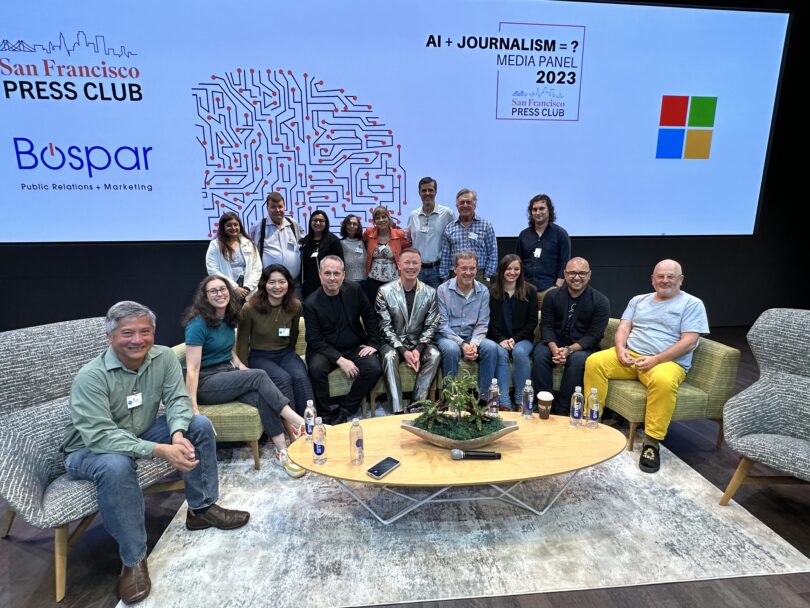The intersection of journalism and AI is the most important media issue of our time.
You can stop reading there.
But if you must continue, then let’s consider the explosive growth of generative AI technologies like ChatGPT and Google Bard. That means there aren’t any journalists — or their end-user readers — who won’t be touched by AI-generated content.
That’s why Bospar sponsored a San Francisco Press Club panel covering the impact of AI in the newsroom, titled “AI + Journalism=?”
Hosted at Microsoft’s Silicon Valley campus and moderated by Bloomberg reporter Rachel Metz, it featured perspectives from Steve Clayton, vice president of public affairs at Microsoft; Krystal Hu, VC and tech investments reporter of Reuters; Michael Nuñez, editorial director at VentureBeat; Jon Swartz, senior reporter for MarketWatch; Julie Jammot, tech correspondent for Agence France-Presse (AFP); Boone Ashworth, staff writer for WIRED; Ben Pimentel, senior technology reporter for the SF Examiner; and Chris Matyszczyk, columnist, CNET, ZDNET, and Inc.
Each panelist offered perspective on the intersection of AI and journalism. Key takeaways included:
- AI shows both promise and peril. With every new technology, there’s concern that reporters will become obsolete. MarketWatch’s Swartz said that, back when personal computers first hit the newsroom, journalists feared for their jobs. However, 30-plus years later, that obviously isn’t the case. Yet the presence of deep fakes and phony AI-generated interviews requires that journalists must diligently fact-check AI-generated content or research.
- AI is already in newsrooms. Reporters are experimenting with AI, whether as a “curiosity,” or to learn about misinformation and fake AI content. News organizations are experimenting with AI for gathering financial data and for applications like a “virtual sports editor,” who reads scores and stats, as well as monitoring for AI-generated misinformation, particularly around politics.
- AI will become part of news gathering. Digital media brands pioneered the “continuous news” model, and AI will surely support round-the clock reporting efforts. VentureBeat’s Nuñez said, “By the end of this year, I think generative AI will touch every piece of the process of news from ideation to headline generation to story [and] editing.” Look for AI as a way for news organizations to extend their reach and to accomplish more with existing resources — becoming a virtual teammate for many reporters.
- Fact-checking will become more critical. As noted by all panelists, AI can generate reams of content on most any subject. But the actual work of reporting — and ensuring that public-facing content is accurately and ethically sourced, as well as factually correct — will be the work of humans for some time to come.
Emerging AI literacy
Across the journalistic and PR landscape, 2023 will be a year of emerging AI literacy. Just like the general public, the news media and PR/communications pros are seeking to understand more about AI’s practical (and ethical) applications, and its impact on their personal and professional lives. According to Bloomberg’s Metz, “ChatGPT has done a lot for consumer AI literacy, which has been really cool,” and the broader public is learning about “things that are good, and things that are promising, but also things they should be watching out for.”
So, the current state of affairs is that we’re all continuing to learn and adapt AI to our professions. A Bospar survey conducted for the event, explains that 87% of media pros think that “people [are] generally are overly sensitive to generative AI,” and 88% believe it will “make media jobs easier.” Usage continues to grow, as 74% media pros have “worked, or experimented with ChatGPT or other generative AI for work,” and some 78% have used AI “to write at least one sentence in a story.”
Learning not to fear the future
Writing in the March issue of PRSA’s Strategies & Tactics, Aaron Kwittken states that AI “holds the potential to serve as a strong research assistant,” but it is “not yet reliable enough to replace manual research” — echoing the sentiments of our journalist panel. Kwitttken further asserts that “for PR pros particularly, 2023 will be a time to test the waters of ChatGPT, tasking it with low-stakes exercises,” and “communicators who stay ahead of the curve will have the upper hand as this tech continues to advance rapidly.”
As journalists and PR practitioners, now is the time to work with AI and apply it as a creative and productivity tool — without fearing the future.
A comment from AFP’s Julie Jammot effectively sums it up: “It’s now a question of how and when, not whether, media organizations incorporate the technology into their production,” she observes. “As for journalists, the challenging times ahead will hopefully unleash a flight to quality, not some Darwinian mass extinction.”
Curtis Sparrer is the co-founder and principal of Bospar PR. He has represented brands like Snowflake, PayPal, Tetris — even the alien hunters of the SETI Institute! His writing has appeared in Adweek, Forbes, the Dallas Morning News and PRWeek. He is the president of the San Francisco Press Club, serves on the board of PRSA’s Silicon Valley Chapter and is a lifetime member of the National Lesbian Gay Journalist Association.







